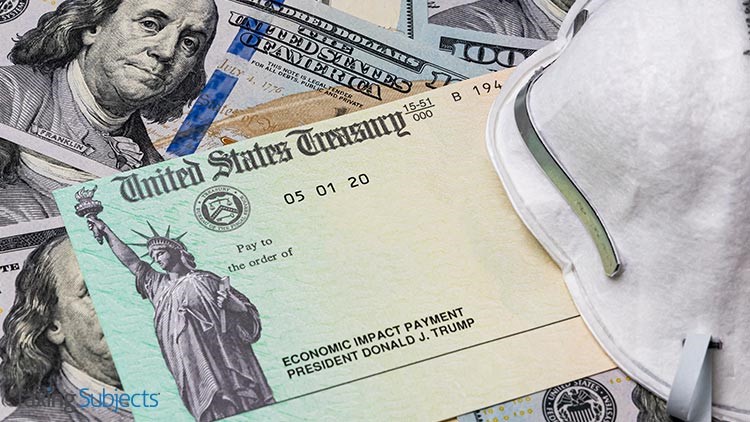by | Oct 10, 2020 | Tax Tips and News
Taxpayers who filed an extension are reminded that the deadline to file their 2019 taxes is looming. Oct. 15 is the deadline to file those tax returns.
Those who still owe tax due are urged to pay as soon as possible to reduce any penalties and interest.
The Internal Revenue Service says taxpayers and tax pros alike should continue to use electronic options to support social distancing and speed processing of tax returns, refunds and tax payments.
Some taxpayers have more time.
While Oct. 15 is the deadline to file, some taxpayers actually have still more time to file, including:
- Members of the military and others serving in a combat zone. They typically have 180 days after they leave the combat zone to file returns and pay any taxes due.
- Taxpayers in federally declared disaster areas who already had valid extensions. For details, see the disaster relief page on IRS.gov.
Choose the direct route for refunds.
The quickest and safest way for taxpayers to get their refunds is to have them deposited electronically into their banks or other financial accounts. Taxpayers can use direct deposit to deposit their refund into one, two or even three accounts. Direct deposit is much faster than waiting for a paper check to arrive in the mail.
Once they’ve filed, taxpayers should use the Where’s My Refund? tool on IRS.gov or download the IRS2Go mobile app to track the status of a refund.
Owe federal taxes? Pay electronically.
Taxpayers can make federal tax payments online, by phone or with their mobile device and the IRS2Go app. When paying federal taxes electronically, taxpayers should remember:
- Electronic payment options are the optimal way to make a tax payment.
- They can pay when they file electronically using tax software online. If using a tax preparer, taxpayers should ask the preparer to make the tax payment through an electronic funds withdrawal from a bank account.
- IRS Direct Pay allows taxpayers to pay online directly from a checking or savings account for free, and to schedule payments up to 365 days in advance.
- Taxpayers can choose to pay with a credit card, debit card or digital wallet option through a payment processor. No fees go to the IRS.
- The IRS2Go app provides the mobile-friendly payment options, including Direct Pay and Card Payment Providers on mobile devices.
- Taxpayers may also enroll in the Electronic Federal Tax Payment System and have a choice of paying online or by phone by using the EFTPS Voice Response System.
- Taxpayers can go to gov/account to securely access information about their federal tax account. They can view the amount they owe, access their tax records online, review their payment history and view key tax return information for the most recent tax return as originally filed.
Several payment options are available on IRS.gov/payments to help taxpayers who can’t pay their tax bill in full. Some of those options can offer smaller penalties.
Taxpayers should know:
- Though interest and late-payment penalties continue to accrue on any unpaid taxes after the original July 15 due date, the failure to pay tax penalty rate is cut in half while an installment agreement is in effect.
- The usual penalty rate of 0.5% per month is reduced to 0.25% per month. For the calendar quarter beginning Oct. 1, 2020, the interest rate for underpayment is 3%.
Got questions? Answers to many taxpayer questions can be found using the Interactive Tax Assistant (ITA), a tax law resource that uses a series of questions and responses. More answers can be found in the Frequently Asked Questions on IRS.gov.
– Story provided by TaxingSubjects.com
by | Oct 9, 2020 | Tax Tips and News
Americans who don’t normally file a tax return now have more time to apply for an Economic Impact Payment (EIP). The Internal Revenue Service this week announced that the deadline for non-filers to send EIP-qualifying information has been extended to November 21, 2020.
Congress passed the CARES Act early in the pandemic, which provides a one-time payment of up to $1,200 for qualifying filers—even those who don’t normally file a tax return. In an effort to make it easier for non-filers to timely send their information to the IRS, the agency created the Non-Filers: Enter Info Here tool.
While the window is closing to apply for an EIP and use the tool, the IRS has given non-filers another month to register.
Who can use the Non-Filers: Enter Info Here tool?
“The Non-Filers tool is designed for people with incomes typically below $24,400 for married couples, and $12,200 for singles who could not be claimed as a dependent by someone else,” the IRS explains. “This includes couples and individuals who are experiencing homelessness.”
Those who want to get their EIP as fast as possible will need to select direct deposit. Otherwise, the IRS says filers will need to wait for a check to arrive in the mail. Regardless of how an EIP is issued, payment status can be tracked with Get My Payment two weeks after applying.
What is the EIP-application deadline for those who normally file a return?
According to the IRS, “[the November 21, 2020 deadline] is solely for those who have not received their EIP and don’t normally file a tax return. For taxpayers who requested an extension of time to file their 2019 tax return, that deadline date remains October 15.”
Don’t expect for this new deadline to get pushed back further. IRS Commissioner Chuck Rettig says “any further extension beyond November would adversely impact our work on the 2020 and 2021 filing seasons.”
Source: IR-2020-229
– Story provided by TaxingSubjects.com
by | Oct 8, 2020 | Tax Tips and News
Cybersecurity pioneer and crypto promoter John McAfee can now add another title to his job description: defendant.
McAfee is well-known in tech circles, first for starting the anti-virus company that bears his name, and later for promoting two particular flavors of cryptocurrency. The Internal Revenue Service says McAfee showed up on their radar screens for tax evasion and willful failure to file tax returns.
The federal indictment was actually handed down in June, but was sealed until the tech millionaire was arrested recently in Spain, where he now awaits extradition to the U.S.
The U.S. Justice Department describes its case this way in a news release: “John McAfee earned millions in income from promoting cryptocurrencies, consulting work, speaking engagements, and selling the rights to his life story for a documentary. From 2014 to 2018, McAfee allegedly failed to file tax returns, despite receiving considerable income from these sources. The indictment does not allege that during these years McAfee received any income or had any connection with the anti-virus company bearing his name.”
McAfee reportedly separated his fortunes from those of the anti-virus company some time ago.
According to the indictment, McAfee allegedly evaded tax liability by directing his income to be paid into bank accounts and crypto exchange accounts in the names of various nominees. The prosecution also alleges McAfee attempted to evade the IRS by concealing real property, a vehicle and a yacht in the names of others.
There were cryptocurrency irregularities.
McAfee also finds himself on the hot seat of the Securities and Exchange Commission (SEC), which accuses him of promoting certain crypto ICOs without disclosing the fact he was paid to do so by the ICO organizers.
The SEC claims McAfee was paid more than $23 million dollars for his efforts, which are alleged to have taken place between 2017 and 2018. The ICOs in question raised more than $41 million for the organizers.
The 55-page SEC filing also includes three other important accusations against McAfee:
- McAfee falsely claimed to be an investor and/or a technical advisor when he recommended several ICOs, creating the impression that he had vetted these companies, that they were benefitting from his technical expertise, and that he was willing to invest his own money in the ventures. In reality, McAfee’s tweets were paid promotions disguised as impartial investment advice.
- After a blogger exposed McAfee’s paid promotions and he could no longer generate interest in ICOs with tweets, McAfee was still holding a large number of virtually worthless securities from the ICOs he had previously touted. To cash out, McAfee encouraged investors to purchase the securities sold in certain of the ICOs without disclosing that he was simultaneously trying to sell his own holdings and had paid another third-party promoter to tout the securities.
- Finally, McAfee engaged in a practice known as “scalping” as to at least one digital asset security, by accumulating large amounts of the digital asset security and touting it on Twitter without disclosing his intent to sell it. Scalping generally allows promoters to sell their securities holdings quickly and profitably through market interest that they deceptively generate, and violates the federal securities laws.
If convicted on the tax evasion charges, McAfee faces a maximum sentence of five years in prison on each count of tax evasion and another maximum sentence of one year behind bars for each count of willful failure to file. If convicted, he also faces supervised release, restitution, and monetary penalties.
McAfee’s indictment was handed down in the Western District of Tennessee, under the watchful eyes of Principal Deputy Assistant Attorney General Richard E. Zuckerman of the Justice Department’s Tax Division and U.S, Attorney D. Michael Dunavant of the district. Zuckerman and Dunavant both credited the special agents of the IRS Criminal Investigation division for their hard work in the case.
Note: An indictment merely alleges that crimes have been committed. The defendant is presumed innocent until proven guilty beyond a reasonable doubt.
– Story provided by TaxingSubjects.com
by | Oct 6, 2020 | Tax Tips and News
Achieving a Better Life Experience (ABLE) accounts now have final regulations from the Internal Revenue Service. Published last Thursday, this is the latest in a series of recently published final regulations that address changes to programs and rules affected by the 2017 Tax Cuts and Jobs Act.
What is an Achieving a Better Life Experience (ABLE) Account?
ABLE accounts were created by the 2014 ABLE Act to provide tax-advantaged savings accounts for paying expenses related to a disability. The IRS says that distributions and earnings from ABLE accounts will not be taxed when used to pay for any of the following qualified disability expenses:
- Housing
- Education
- Transportation
- Health
- Prevention and wellness
- Employment training and support
- Assistive technology and personal support services
- Other disability-related expenses
While using money from an ABLE account to pay certain expenses is tax-free, the IRS notes that “contributions are not deductible.”
What was included in the final regulations for ABLE accounts?
The ABLE Account final regulations address comments from proposed regulations and guidance for a number of issues:
- Recordkeeping and reporting requirements
- Gift and generation-skipping transfer tax consequences of contributions
- Federal income, gift, and estate tax consequences of distributions
- Changing the designated beneficiary
- Beneficiary eligibility for the saver’s credit
- Rolling over funds from the designated beneficiary’s 529 qualified tuition program account
Check out the ABLE account final regulations for more information.
Read more about ABLE accounts on IRS.gov:
Read more about recently published final regulations:
Source: IR-2020-227
– Story provided by TaxingSubjects.com
by | Oct 6, 2020 | Tax Tips and News
As we’ve mentioned before, the Internal Revenue Service has been fighting abusive tax shelters that use syndicated conservation easements as their main vehicle. More details have now been released on how their prosecution may unfold.
The IRS Chief Counsel has released Chief Counsel Notice 2021-001, also termed “CC Notice,” containing information on the Chief Counsel’s settlement initiative for certain pending Tax Court Cases.
The cases involve abusive syndicated conservation easement transactions laid out in IRS Notice 2017-10 (“SCE Transactions”). Previous details of the settlement initiative can be found in the IRS news release IR-2020-196.
“The IRS encourages investors to seek independent professional assistance with understanding the settlement terms and CC Notice, and to help them assess their hazards of litigation. Investors would be well advised to obtain counsel from competent, independent advisers not related to or recommended by the SCE transaction promoter,” the IRS writes.
The IRS assesses its effort to crack down on these abusive tax schemes as “very successful.”
The IRS isn’t convinced by the “different” defense.
Some promoters, the IRS notes, have tried to distance their particular scheme from those in the IRS crosshairs, claiming their transactions are “different” and don’t suffer from the same flaws as the stated plans.
The agency will soon publish updates to the Conservation Easement Audit Technique Guide that set out new arguments that taxpayers can expect the IRS to make in SCE cases.
The newly established Office of Fraud Enforcement and the National Fraud Counsel are teaming up with examining agents and Chief Counsel attorneys to canvas cases for additional fraud considerations, which might include assertion of the 75% civil fraud penalty, or where applicable, referrals to Criminal Investigation.
The CC Notice, the IRS reminds, also responds to a frequent question raised by several groups of partners who have approached the IRS Chief Counsel, asking to resolve their cases. The Chief Counsel settlement initiative requires the partnership engaged in the SCE transaction – and all of its partners – to agree to settle on the terms offered by the IRS.
The terms include a complete disallowance of the claimed charitable contribution deductions and penalties, although some partners may deduct their cost of investing in the partnership. In rare cases, Chief Counsel has the authority to permit less than all the partners to settle on these terms.
Why are some settling groups paying an additional penalty?
In most cases, though, the IRS will demand that settling groups of less than all partners pay an additional 5% penalty, offsetting the lost efficiencies of the IRS having to proceed with the partnership case.
The IRS and the Chief Counsel’s office encourage partners who want to settle to work with the other partners to reach a full resolution of the case. The CC Notice also shows the IRS will settle with individual partners (or groups of individual partners) only if they own a significant percentage of the partnership and they cooperate with the Chief Counsel. Such cooperation may include providing evidence the Chief Counsel might use to support the IRS’ position in court.
Individual partners or groups of partners have just 30 days from the date of the CC Notice to elect to settle.
The CC Notice also explains that the Chief Counsel may consider making the same settlement offer to newly filed cases in Tax Court. The Chief Counsel’s office can consider a wide number of factors when deciding whether to extend the settlement offer – including whether the partnership fully cooperated with the IRS during the audit.
Source: IR-2020-130
– Story provided by TaxingSubjects.com
by | Oct 2, 2020 | Tax Tips and News
The Internal Revenue Service closed out September by announcing the publication of final regulations for the business-related entertainment deductions that were removed from section 274 by the Tax Cuts and Jobs Act.
Corporations celebrated the new 21 percent tax rate and small businesses took advantage of the section 199A qualified business deduction, but the TCJA elimination of “entertainment, amusement, or recreation activities” was a far less popular change.
Business relationships are like any other relationship: shaped by shared experiences. That’s why taking clients and potential business partners to concerts and baseball games as part of a business discussion was long seen as an essential part of sealing a deal. Despite the removal of most such deductions in the TCJA, some still remain.
What business entertainment deductions can taxpayers still claim?
The IRS points out in the final regulations that “Congress did not amend the provisions relating to the deductibility of business meals. Thus, taxpayers generally may continue to deduct 50 percent of the food and beverage expenses associated with operating their trade or business, including meals consumed by employees on work travel” (TD-9925, 5).
Since the TCJA didn’t make changes to business meals, the old restrictions still apply: “No deduction is allowed for the expense of any food or beverages unless (a) the expense is not lavish or extravagant under the circumstances, and (b) the taxpayer (or an employee of the taxpayer) is present at the furnishing of the food or beverages” (5).
To learn more about which business entertainment deductions are and are not allowed, check out the TD-9925. The IRS also recommends taking a look at their “Tax Reform” page for a broad overview of all TCJA-related changes.
Want to read about other final regulations?
Source: IR-2020-225
– Story provided by TaxingSubjects.com






